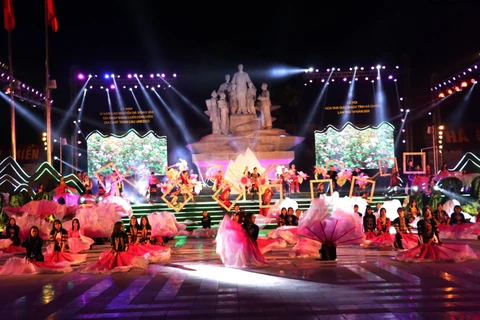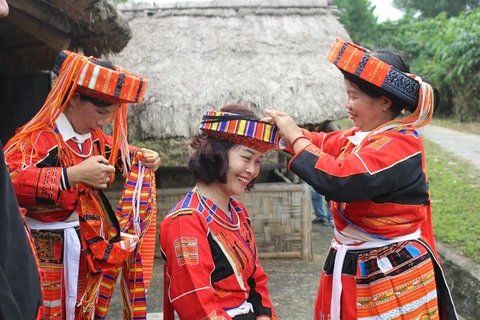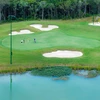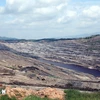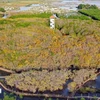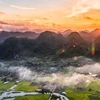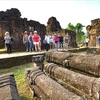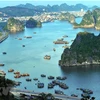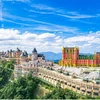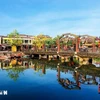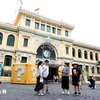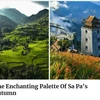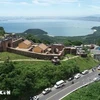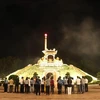
 Beautiful fields of buckwheat flower, framed by magnificent limestone mountains, have become attractive destinations for tourists in Ha Giang province in recent years. The province hopes to draw more tourists by showcasing its natural attractions. Buckwheat is cultivated for its grain-like seeds, which are used to make specialty food by ethnic minorities in the mountainous region. It is often planted around September. From late October to early November, large fields of buckwheat flower are in full bloom, making a spectacular sight. The hills and mountains are covered by the white and pink of the flower. The flower symbolises love and happiness, so many couples shoot their wedding photos in these fields. (Photo: VietnamPlus)
Beautiful fields of buckwheat flower, framed by magnificent limestone mountains, have become attractive destinations for tourists in Ha Giang province in recent years. The province hopes to draw more tourists by showcasing its natural attractions. Buckwheat is cultivated for its grain-like seeds, which are used to make specialty food by ethnic minorities in the mountainous region. It is often planted around September. From late October to early November, large fields of buckwheat flower are in full bloom, making a spectacular sight. The hills and mountains are covered by the white and pink of the flower. The flower symbolises love and happiness, so many couples shoot their wedding photos in these fields. (Photo: VietnamPlus)  The maleficent beauty of the gigantic cliffs of Ha Giang is coupled with the romantic and poetic scene of the buckwheat flower fields. Ha Giang province has a population of 800,000, 90 percent of whom are ethnic minorities with their unique culture and lifestyle. The province draws tourists with its endless terraced rice fields, buckwheat flower fields and grandiose mountain landscapes. One of the most beautiful sites in the province is the Dong Van Karst Global Geopark, designated by UNESCO as one of 77 sites with important geological and cultural value. The geopark is littered with ethereal karst formations that are nearly 400 million years old. (Photo: VietnamPlus)
The maleficent beauty of the gigantic cliffs of Ha Giang is coupled with the romantic and poetic scene of the buckwheat flower fields. Ha Giang province has a population of 800,000, 90 percent of whom are ethnic minorities with their unique culture and lifestyle. The province draws tourists with its endless terraced rice fields, buckwheat flower fields and grandiose mountain landscapes. One of the most beautiful sites in the province is the Dong Van Karst Global Geopark, designated by UNESCO as one of 77 sites with important geological and cultural value. The geopark is littered with ethereal karst formations that are nearly 400 million years old. (Photo: VietnamPlus)  The site has become an ideal “check-in” spot for young people. Tourists become spellbound by the magnificent rocky plateaus, winding passes, picturesque terraced fields and especially enchanting buckwheat flower fields. Buckwheat is cultivated for its grain-like seeds, which are used to make specialty food by ethnic minorities in the mountainous region. Year-end is the time when buckwheat flower fields burst into full bloom, embellishing the beauty of Ha Giang, located in the far north of Vietnam. The hills and mountains are covered by the white and pink of the flower. The flower symbolises love and happiness, so many couples shoot their wedding photos in these fields. (Photo: VietnamPlus)
The site has become an ideal “check-in” spot for young people. Tourists become spellbound by the magnificent rocky plateaus, winding passes, picturesque terraced fields and especially enchanting buckwheat flower fields. Buckwheat is cultivated for its grain-like seeds, which are used to make specialty food by ethnic minorities in the mountainous region. Year-end is the time when buckwheat flower fields burst into full bloom, embellishing the beauty of Ha Giang, located in the far north of Vietnam. The hills and mountains are covered by the white and pink of the flower. The flower symbolises love and happiness, so many couples shoot their wedding photos in these fields. (Photo: VietnamPlus)  The crop is often planted around September. From late October to early November, large fields of buckwheat flower are in full bloom, making a spectacular sight. At this time of the year, an annual festival to honour the buckwheat flower, the most iconic flower of the province, and the unique cultural values of Ha Giang province’s local ethnic groups takes place in Dong Van district. The one-month event includes a variety of activities, such as photo exhibitions, buckwheat flower arrangement displays, an exhibition of products from buckwheat flower, musical performances and folk games of some ethnic groups’ festivals. Together with strengthening agricultural production, the province has chosen tourism as one of the key industries. (Photo: VietnamPlus)
The crop is often planted around September. From late October to early November, large fields of buckwheat flower are in full bloom, making a spectacular sight. At this time of the year, an annual festival to honour the buckwheat flower, the most iconic flower of the province, and the unique cultural values of Ha Giang province’s local ethnic groups takes place in Dong Van district. The one-month event includes a variety of activities, such as photo exhibitions, buckwheat flower arrangement displays, an exhibition of products from buckwheat flower, musical performances and folk games of some ethnic groups’ festivals. Together with strengthening agricultural production, the province has chosen tourism as one of the key industries. (Photo: VietnamPlus)  Capitalising on tourists’ demand, many local residents have invested in buckwheat flower fields offering check-in services, with entrance ticket fees ranging only from 10,000 VND to 20,000 VND (0.45 – 0.9 USD) per person. Ha Giang has been endowed with many magnificent unspoiled landscapes. With the aim of turning difficulties into momentum for development, the local authorities and ethnic people have constantly made great efforts and worked together to reduce poverty. Over the past years, Ha Giang has become an attractive destination for both domestic and foreign holiday-makers whose number increased 14 percent each year during the 2010-2015 period, and 14.6 percent between 2015 and 2020, contributing 8.8 percent to the local gross regional domestic product (GRDP). (Photo: VietnamPlus)
Capitalising on tourists’ demand, many local residents have invested in buckwheat flower fields offering check-in services, with entrance ticket fees ranging only from 10,000 VND to 20,000 VND (0.45 – 0.9 USD) per person. Ha Giang has been endowed with many magnificent unspoiled landscapes. With the aim of turning difficulties into momentum for development, the local authorities and ethnic people have constantly made great efforts and worked together to reduce poverty. Over the past years, Ha Giang has become an attractive destination for both domestic and foreign holiday-makers whose number increased 14 percent each year during the 2010-2015 period, and 14.6 percent between 2015 and 2020, contributing 8.8 percent to the local gross regional domestic product (GRDP). (Photo: VietnamPlus)  Those who travel to Ha Giang but have yet to visit the buckwheat flower fields are believed to fall into a long time of regret. Beautiful fields of buckwheat flower, framed by magnificent limestone mountains, have become an attractive destination for tourists in Ha Giang province in recent years. The crop is often planted around September. From late October to early November, carpets of buckwheat flower are in full bloom, making a spectacular sight. The hills and mountains are covered by the white and pink of the flower. The flower symbolises love and happiness, so many couples shoot their wedding photos in these fields. (Photo: VietnamPlus)
Those who travel to Ha Giang but have yet to visit the buckwheat flower fields are believed to fall into a long time of regret. Beautiful fields of buckwheat flower, framed by magnificent limestone mountains, have become an attractive destination for tourists in Ha Giang province in recent years. The crop is often planted around September. From late October to early November, carpets of buckwheat flower are in full bloom, making a spectacular sight. The hills and mountains are covered by the white and pink of the flower. The flower symbolises love and happiness, so many couples shoot their wedding photos in these fields. (Photo: VietnamPlus)  Buckwheat is cultivated for its grain-like seeds, which are used to make specialty food by ethnic minorities in the mountainous region. In November, Ha Giang held a ceremony to celebrate the 10th anniversary of UNESCO’s recognition of the Dong Van Karst Plateau as a global geopark and kicked off the sixth buckwheat flower festival. According to UNESCO, most of the Dong Van Karst Plateau’s surface is limestone (about 60 percent). Its landscape is spectacular and unique having high mountains and deep canyons. The highest peak is Mieu Vac Mount (1971m) while Tu San is the deepest canyon (700-800 m deep). The geopark is located at an extension foot mount East of the Himalayas. (Photo: VietnamPlus)
Buckwheat is cultivated for its grain-like seeds, which are used to make specialty food by ethnic minorities in the mountainous region. In November, Ha Giang held a ceremony to celebrate the 10th anniversary of UNESCO’s recognition of the Dong Van Karst Plateau as a global geopark and kicked off the sixth buckwheat flower festival. According to UNESCO, most of the Dong Van Karst Plateau’s surface is limestone (about 60 percent). Its landscape is spectacular and unique having high mountains and deep canyons. The highest peak is Mieu Vac Mount (1971m) while Tu San is the deepest canyon (700-800 m deep). The geopark is located at an extension foot mount East of the Himalayas. (Photo: VietnamPlus)  Beautiful fields of buckwheat flower, framed by magnificent limestone mountains, have become a can-not-miss attraction for tourists in Ha Giang province in recent years. Capitalising on tourists’ demand, many local residents have invested in buckwheat flower fields offering check-in services, with entrance ticket fees ranging only from 10,000 VND to 20,000 VND (0.45 – 0.9 USD) per person. Ha Giang has been endowed with many magnificent unspoiled landscapes. With the aim of turning difficulties into momentum for development, the local authorities and ethnic people have constantly made great efforts and worked together to reduce poverty. The buckwheat flower festival has been regarded as a highlight for years to promote local culture. (Photo: VietnamPlus)
Beautiful fields of buckwheat flower, framed by magnificent limestone mountains, have become a can-not-miss attraction for tourists in Ha Giang province in recent years. Capitalising on tourists’ demand, many local residents have invested in buckwheat flower fields offering check-in services, with entrance ticket fees ranging only from 10,000 VND to 20,000 VND (0.45 – 0.9 USD) per person. Ha Giang has been endowed with many magnificent unspoiled landscapes. With the aim of turning difficulties into momentum for development, the local authorities and ethnic people have constantly made great efforts and worked together to reduce poverty. The buckwheat flower festival has been regarded as a highlight for years to promote local culture. (Photo: VietnamPlus)  The hills and mountains are covered by the white and pink of the buckwheat flower, the most iconic flower of the northern mountainous province. A festival is held annually to honour the flower. The event, running for a whole month, includes a variety of activities, such as photo exhibitions, buckwheat flower arrangement displays, an exhibition of products from buckwheat flower and folk games of some ethnic groups. First held in 2015, the festival aims to promote and popularise the image of Ha Giang province among both domestic and international tourists. While promoting tourism in the region, the festival is also expected to improve the livelihoods of the local ethnic people. Thousands of tourists are expected to attend the event. (Photo: VietnamPlus)
The hills and mountains are covered by the white and pink of the buckwheat flower, the most iconic flower of the northern mountainous province. A festival is held annually to honour the flower. The event, running for a whole month, includes a variety of activities, such as photo exhibitions, buckwheat flower arrangement displays, an exhibition of products from buckwheat flower and folk games of some ethnic groups. First held in 2015, the festival aims to promote and popularise the image of Ha Giang province among both domestic and international tourists. While promoting tourism in the region, the festival is also expected to improve the livelihoods of the local ethnic people. Thousands of tourists are expected to attend the event. (Photo: VietnamPlus)  Tourists become romantic in the sea of flowers. According to UNESCO, most of the Dong Van Karst Plateau’s surface is limestone (about 60 percent). Its landscape is spectacular and unique having high mountains and deep canyons. The highest peak is Mieu Vac Mount (1,971m) while Tu San is the deepest canyon (700-800 m deep). It is home to 17 ethnic groups, creating the unique and rich cultural heritage of this area. UNESCO’s recognition has created new opportunities for socio-economic development in Ha Giang and four districts in the karst plateau area in particular. Meanwhile, the buckwheat flower festival has been regarded as a highlight for years to promote local culture. (Photo: VietnamPlus)
Tourists become romantic in the sea of flowers. According to UNESCO, most of the Dong Van Karst Plateau’s surface is limestone (about 60 percent). Its landscape is spectacular and unique having high mountains and deep canyons. The highest peak is Mieu Vac Mount (1,971m) while Tu San is the deepest canyon (700-800 m deep). It is home to 17 ethnic groups, creating the unique and rich cultural heritage of this area. UNESCO’s recognition has created new opportunities for socio-economic development in Ha Giang and four districts in the karst plateau area in particular. Meanwhile, the buckwheat flower festival has been regarded as a highlight for years to promote local culture. (Photo: VietnamPlus)  One of the beautiful moments in the flower fields. The site has become an ideal “check-in” spot for young people. Tourists become spellbound by the magnificent rocky plateaus, winding passes, picturesque terraced fields and especially enchanting buckwheat flower fields. Buckwheat is cultivated for its grain-like seeds, which are used to make specialty food by ethnic minorities in the mountainous region. The crop is often planted around September. From late October to early November carpets of buckwheat flowers are in full bloom, making a spectacular sight. The hills and mountains are covered by the white and pink of the flower. The flower symbolises love and happiness, so many couples shoot their wedding photos in these fields. (Photo: VietnamPlus)
One of the beautiful moments in the flower fields. The site has become an ideal “check-in” spot for young people. Tourists become spellbound by the magnificent rocky plateaus, winding passes, picturesque terraced fields and especially enchanting buckwheat flower fields. Buckwheat is cultivated for its grain-like seeds, which are used to make specialty food by ethnic minorities in the mountainous region. The crop is often planted around September. From late October to early November carpets of buckwheat flowers are in full bloom, making a spectacular sight. The hills and mountains are covered by the white and pink of the flower. The flower symbolises love and happiness, so many couples shoot their wedding photos in these fields. (Photo: VietnamPlus)  Ha Giang is loved by visitors for its untouched, majestic and poetic landscapes with rocky massive mountains, terraced rice fields that paint the valleys with yellow colour in harvest season and mirror the sky colours in the sowing season. The land also owns various historical relic sites and landscapes such as the Heaven’s Gate and Quan Ba twin mountains (Quan Ba district); the Vuong family palace and Lung Cu national flagpole (Dong Van district); Ma Pi Leng Pass (Meo Vac district); Tien waterfall – Gio pass and the ancient rock field of Nam Dan (Xin Man district); and Quang Ngan mineral stream in Vi Xuyen district. (Photo: VietnamPlus)
Ha Giang is loved by visitors for its untouched, majestic and poetic landscapes with rocky massive mountains, terraced rice fields that paint the valleys with yellow colour in harvest season and mirror the sky colours in the sowing season. The land also owns various historical relic sites and landscapes such as the Heaven’s Gate and Quan Ba twin mountains (Quan Ba district); the Vuong family palace and Lung Cu national flagpole (Dong Van district); Ma Pi Leng Pass (Meo Vac district); Tien waterfall – Gio pass and the ancient rock field of Nam Dan (Xin Man district); and Quang Ngan mineral stream in Vi Xuyen district. (Photo: VietnamPlus)  In 2010, the Dong Van Karst Plateau Geopark was recognised as the first Global UNESCO Geopark of Vietnam and the second in Southeast Asia after the Langkawi of Malaysia. The geopark has two natural conservation areas rich in fauna and flora species and many species of bird, such as conifers, Asian black bear, Southern serow (a solitary mountain goat) and many species of bird. UNESCO’s recognition has created new opportunities for socio-economic development in Ha Giang and four districts in the karst plateau area in particular. Travelling to the site in October and November, visitors will have the chance to enjoy the beauty of buckwheat flower blossoming season. (Photo: VietnamPlus)
In 2010, the Dong Van Karst Plateau Geopark was recognised as the first Global UNESCO Geopark of Vietnam and the second in Southeast Asia after the Langkawi of Malaysia. The geopark has two natural conservation areas rich in fauna and flora species and many species of bird, such as conifers, Asian black bear, Southern serow (a solitary mountain goat) and many species of bird. UNESCO’s recognition has created new opportunities for socio-economic development in Ha Giang and four districts in the karst plateau area in particular. Travelling to the site in October and November, visitors will have the chance to enjoy the beauty of buckwheat flower blossoming season. (Photo: VietnamPlus)  Visitors can take photos with local children and baskets full of buckwheat flower at tourist destinations. Dong Van karst plateau is a dry place with scarce water and soil. Locals have planted buckwheat as a source of food. The plant can be eaten as a kind of vegetable while its seeds can be ground for flour to make soup and cakes. Ha Giang province has a population of 800,000, 90 percent of whom are ethnic minority people with their unique culture and lifestyle. The north western mountainous province, home to more than 20 ethnic minority groups with unique cultural identities and festivals, has long been an attractive destination for tourists and explorers. (Photo: VietnamPlus)
Visitors can take photos with local children and baskets full of buckwheat flower at tourist destinations. Dong Van karst plateau is a dry place with scarce water and soil. Locals have planted buckwheat as a source of food. The plant can be eaten as a kind of vegetable while its seeds can be ground for flour to make soup and cakes. Ha Giang province has a population of 800,000, 90 percent of whom are ethnic minority people with their unique culture and lifestyle. The north western mountainous province, home to more than 20 ethnic minority groups with unique cultural identities and festivals, has long been an attractive destination for tourists and explorers. (Photo: VietnamPlus)  A young local girl stands next to a basket of buckwheat flower, with the paddy fields and mountains at the background. Ha Giang has been endowed with many magnificent unspoiled landscapes. With the aim of turning difficulties into momentum for development, the local authorities and ethnic people have constantly made great efforts and worked together to reduce poverty. Over the past years, Ha Giang has become an attractive destination for both domestic and foreign holidaymakers whose number increased 14 percent each year during the 2010-2015 period, and 14.6 percent between 2015 and 2020, contributing 8.8 percent to the local gross regional domestic product (GRDP). (Photo: VietnamPlus)
A young local girl stands next to a basket of buckwheat flower, with the paddy fields and mountains at the background. Ha Giang has been endowed with many magnificent unspoiled landscapes. With the aim of turning difficulties into momentum for development, the local authorities and ethnic people have constantly made great efforts and worked together to reduce poverty. Over the past years, Ha Giang has become an attractive destination for both domestic and foreign holidaymakers whose number increased 14 percent each year during the 2010-2015 period, and 14.6 percent between 2015 and 2020, contributing 8.8 percent to the local gross regional domestic product (GRDP). (Photo: VietnamPlus) VNA

